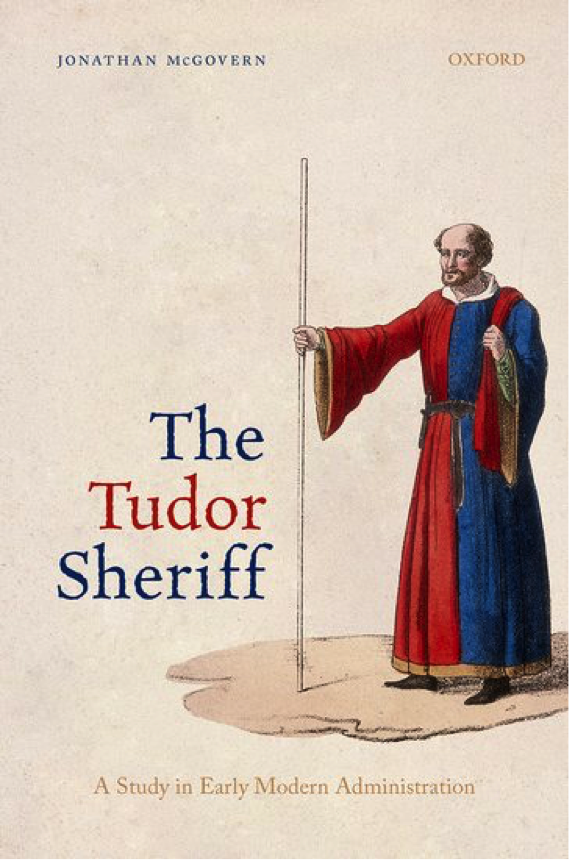Editor’s Note: Oxford University Press will be publishing Jonathan McGovern’s book, The Tudor Sheriff: A Study in Early Modern Administration, in early 2022. Dr. McGovern recently agreed to provide our readers a short preview of the book.

The sheriff is one of the most iconic local officials in the United States. Many of us living in other countries imagine American sheriffs as hard-nosed and firm but fair, as recently portrayed in the popular television series Longmire (2012–17). The United Kingdom also has sheriffs, although today they are largely ceremonial, as do Canada, Australia and New Zealand. On 12 February 2018, the former US Attorney General Jeff Sessions described the sheriff as a ‘critical part of the Anglo-American heritage of law enforcement.’[1] Though his comments were thought to be controversial, it is of course indisputable that that the office of sheriff originated in England.
Sheriffs were introduced by the Anglo-Saxon state in the tenth century. From the outset, they were generalist royal officers responsible for punishing offenders, collecting the king’s revenue, peacekeeping and court-holding. When the Normans conquered England in the eleventh century, they decided to preserve the useful office of sheriff, and indeed even augmented its significance. The Norman sheriffs have been described as ‘kings of their counties’, for they enjoyed sweeping executive powers.
It is commonly thought that the importance of the office of sheriff declined in the fourteenth century. While this argument can be exaggerated, it is true that the office became more professionalized and regulated over the course of this century, thanks to a series of laws passed by Parliament. Nevertheless, the sheriff remained a key player in local administration until relatively modern times. The Encyclopedia Britannica is quite wrong to state that ‘[a]fter the Tudor reorganization of local government in the 15th and 16th centuries, the office was largely ceremonial.’[2] Indeed, in 1566, the privy council of Queen Elizabeth I described the sheriff as ‘her Majesty’s chief minister and officer of [the] county.’[3]
Sheriffs could only serve for a year at a time.[4] There was a crucial distinction between high (or county) sheriffs and municipal sheriffs. While the former were appointed directly by the king, the latter were elected by the corporations of their respective towns and cities. High sheriffs were elected by an unusual process: first of all, leading officials met with the Westminster justices at the Upper Exchequer to shortlist three candidates for each shire. This shortlist was then presented to the king or queen, who signified their final choice by making small holes in the parchment with a needle or bodkin. This process became known as ‘pricking for sheriffs.’ There is a tale that Queen Elizabeth began the tradition of ‘pricking’ because on the day of selection she had had no pen to hand, only a sewing needle. Unfortunately, the facts dispel a pleasant fiction: King Henry VIII was the first monarch to prick the lists, and of all the Tudors he was the least likely to have sewn his own buttons.[5]
High sheriffs were normally drawn from the ranks of the landed gentry, and many were legally trained. In 1970, Terrence E. Hartley (1970) estimated that around 60% of Elizabethan sheriffs had been to the Inns of Court.[6] They had an astonishingly broad portfolio of duties, including executing the king’s writ, holding local courts, managing county and municipal prisons, arresting suspected felons, hanging convicted criminals and traitors, collecting and accounting for royal revenue, seizing forfeited property, mustering soldiers, making proclamation and holding parliamentary elections.
I have recently completed a full study of the office of sheriff in Tudor England (1485–1603), entitled The Tudor Sheriff: A Study in Early Modern Administration (Oxford University Press, 2022). This monograph combines administrative history with legal history to reconstruct how the shrieval system operated in the sixteenth century. It forms part of a general pivot towards administrative history in medieval and early modern studies – ‘the history of institutions and those who operate them.’[7] Early modern administrative history was booming from around 1950 to around 1990, but it was thereafter supplanted by other genres such as the ‘new political history’ and the ‘social history of politics.’ I hope that my new book demonstrates the continuing vitality and usefulness of administrative history. It will contribute to what I and others have referred to as the ‘new administrative history.’[8]
[1] Maegan Vazquez, ‘Sessions invokes “Anglo-American heritage” of sheriff’s office’, CNN, 12 February 2018.
[2] ‘Sheriff’, Encyclopedia Britannica, April 11, 2018.
[3] John Roche Dasent, ed., Acts of the Privy Council of England, vol. 7 (London: Her Majesty’s Stationery Office, 1893), 335.
[4] 14 Edward III, c. 7.
[5] Jean S. Wilson, ‘Sheriffs’ Rolls of the Sixteenth and Seventeenth Centuries’, English Historical Review 47, no. 185 (1932), 33, note 4.
[6] T. E. Hartley, ‘The Sheriffs of the County of Kent, c. 1580 – c. 1625’, PhD thesis (University of London, 1970), 11.
[7] G. R. Elton, Political History: Principles and Practice (New York: Basic Books, 1970), 24.
[8] Jonathan McGovern, ‘Royal Counsel in Tudor England, 1485–1603’, The Historical Journal (2021), FirstView, 27. doi:10.1017/S0018246X21000820.

